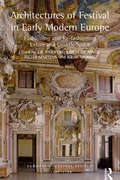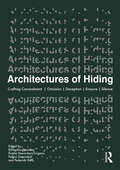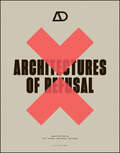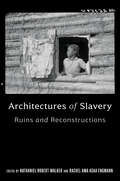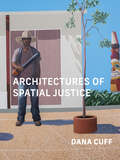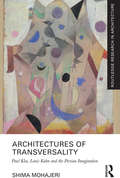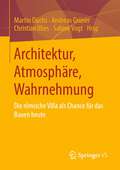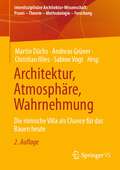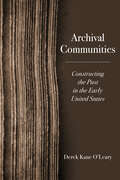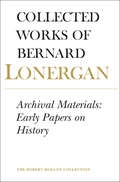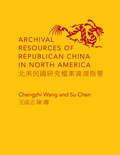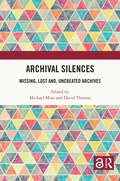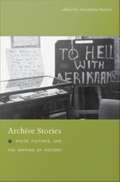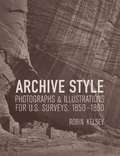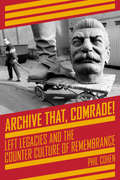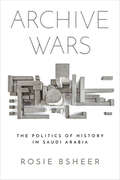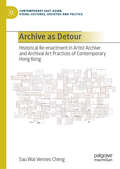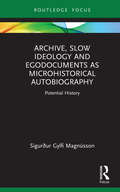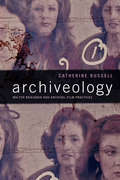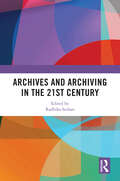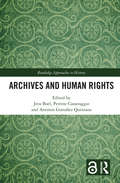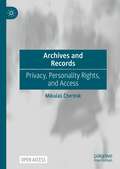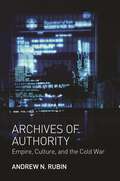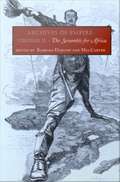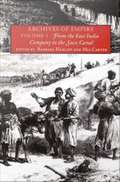- Table View
- List View
Architectures of Festival in Early Modern Europe: Fashioning and Re-fashioning Urban and Courtly Space (European Festival Studies: 1450-1700)
by Krista De Jonge J. R. Mulryne R.L.M. Morris Pieter MartensThis fourth volume in the European Festival Studies, 1450–1700 series breaks with precedent in stemming from a joint conference (Venice, 2013) between the Society for European Festivals Research and the PALATIUM project supported by the European Science Foundation. The volume draws on up-to-date research by a Europe-wide group of academic scholars and museum and gallery curators to provide a unique, intellectually-stimulating and beautifully-illustrated account of temporary architecture created for festivals of the sixteenth and seventeenth centuries, together with permanent architecture pressed into service for festival occasions across major European locations including Italian, French, Austrian, Scottish and German. Appealing and vigorous in style, the essays look towards classical sources while evoking political and practical circumstances and intellectual concerns – from re-shaping and re-conceptualizing early sixteenth-century Rome, through providing for the well-being and political allegiance of Medici-era Florentines and exploring the teasing aesthetics of performance at Versailles to accommodating players and spectators in seventeenth-century Paris and at royal and ducal events for the Habsburg, French and English crowns. The volume is unique in its field in the diversity of its topics and the range of its scholarship and fascinating in its account of the intellectual and political life of Early Modern Europe.
Architectures of Hiding: Crafting Concealment | Omission | Deception | Erasure | Silence
by Federica Goffi Rana Abughannam Émélie Desrochers-Turgeon Pallavi SwaranjaliArchitecture manifests as a space of concealment and unconcealment, lethe and alêtheia, enclosure and disclosure, where its making and agency are both hidden and revealed. With an urgency to amplify narratives that are overlooked, silenced and unacknowledged in and by architectural spaces, histories and theories, this book contends the need for a critical study of hiding in the context of architectural processes. It urges the understanding of inherent opportunities, power structures and covert strategies, whether socio-cultural, geo-political, environmental or economic, as they are related to their hidescapes – the constructed landscapes of our built environments participating in the architectures of hiding. Looking at and beyond the intentions and agency that architects possess, architectural spaces lend themselves as apparatuses for various forms of hiding and un(hiding). The examples explored in this book and the creative works presented in the interviews enclosed in the interludes of this publication cover a broad range of geographic and cultural contexts, discursively disclosing hidden aspects of architectural meaning. The book investigates the imaginative intrigue of concealing and revealing in design processes, along with moral responsibilities and ethical dilemmas inherent in crafting concealment through the making and reception of architecture.
Architectures of Refusal (Architectural Design)
by Jill Stoner Ozayr SaloojeeGuest-edited by Jill Stoner and Ozayr Saloojee Over the past decade, and in a more concentrated form over the past two years, there has been increasing recognition of architecture’s systemic complicity in constructing and upholding hierarchies of race and class, and privileging colonial paradigms that perpetuate spatial and economic inequity. This AD issue reveals how designers, practitioners, scholars and architects are participating in dismantling the major canons of Western architecture. The work is both literal and figural: taking buildings apart and reconstituting them, and challenging mythologies that include drawing-as-analogue, building-as object, architect-as-hero and nature-as-other. Architecture has both potential and responsibility for political agency in the public realm. The contributions to this issue foreground emancipatory spatial ideas and practices from around the world, demonstrating that refusal is no longer just absence and denial, but a constructive mode of resistance and action that needs to be approached through subversive urban works, design pedagogy and alliances across multiple disciplines. Contributors: Piper Bernbaum, Carwil Bjork-James, Thiresh Govender, Lucia Jalón Oyarzun, Jennifer Newsom and Tom Carruthers, Cong Chi Nguyen, Quilian Riano, Hannah Le Roux, Alberto de Salvatierra, Cathy Smith, Chat Travieso, and Ilze Wolff.
Architectures of Slavery: Ruins and Reconstructions (Race, Place, and Justice)
by Nathaniel Robert Walker Rachel Ama Asaa EngmannThe material legacies of slavery across the Atlantic world Atlantic slavery has bequeathed architectural legacies from the plantation ruins that fill the valleys of Cuba to the servant&’s quarters of middle-class apartment housing in Brazil; from picturesque New England waterfronts to the modernist ranch-house suburbs of Savannah; and from the castle-studded coastline of Ghana to steel-framed commercial high-rises in South Carolina. The stories of these places are woven together by historical threads stretched across the past five hundred years, connecting them first through empire and forced migration, then by modern economic development and heritage tourism. Architectures of Slavery brings new clarity and critical insight to these visible injustices that still haunt so many societies in the Atlantic world, empowering its people to build more democratic and just places in the future.
Architectures of Spatial Justice
by Dana CuffA field-defining work that demonstrates how architects are breaking with professional conventions to advance spatial justice and design more equitable buildings and cities.As state violence, the pandemic, and environmental collapse have exposed systemic inequities, architects and urbanists have been pushed to confront how their actions contribute to racism and climate crisis—and how they can effect change. Establishing an ethics of spatial justice to lead architecture forward, Dana Cuff shows why the discipline requires critical examination—in relation to not only buildings and the capital required to realize them but privilege, power, aesthetics, and sociality. That is, it requires a reevaluation of architecture&’s fundamental tenets.Organized around projects and topics, Architectures of Spatial Justice is a compelling blend of theory, history, and applied practice that focuses on two foundational conditions of architecture: its relation to the public and its dependence on capital. The book draws on studies of architectural projects from around the world, with instructive case studies from Chile, Mexico, Japan, and the United States that focus in particular on urban centers, where architecture is most directly engaged with social justice issues.Emerging from more than two decades of the author&’s own project-based research, Architectures of Spatial Justice examines ethically driven practices that break with professional conventions to correct long-standing inequities in the built environment, uncovering architecture&’s limits—and its potential.
Architectures of Transversality: Paul Klee, Louis Kahn and the Persian Imagination (Routledge Research in Architecture)
by Shima MohajeriArchitectures of Transversality investigates the relationship between modernity, space, power, and culture in Iran. Focusing on Paul Klee’s Persian-inspired miniature series and Louis Kahn’s unbuilt blueprint for a democratic public space in Tehran, it traces the architectonics of the present as a way of moving beyond universalist and nationalist accounts of modernism. Transversality is a form of spatial production and practice that addresses the three important questions of the self, objects, and power. Using Deleuzian and Heideggerian theory, the book introduces the practices of Klee and Kahn as transversal spatial responses to the dialectical tension between existential and political territories and, in doing so, situates the history of the silent, unrepresented and the unbuilt – constructed from the works of Klee and Kahn – as a possible solution to the crisis of modernity and identity-based politics in Iran.
Architektur, Atmosphäre, Wahrnehmung: Die römische Villa als Chance für das Bauen heute
by Christian Illies Andreas Grüner Martin Düchs Sabine Vogt„Nach Rom Architekturstudenten zu schicken heißt, sie für ihr ganzes Leben zu ruinieren.“ (Le Corbusier 1922). Im Sinne dieses Verdikts hat sich die Architekturmoderne radikal von der klassizistischen Tradition abgewandt, in der die antike Baukunst als Schulung, Folie und Muster galt, indem man ihre Formen, Strukturen und Proportionen formalästhetisch analysierte und nachahmte. Doch gab es bereits in der Antike ein anderes Konzept von Architekturverständnis: das sinnliche Erleben von Raumsequenzen und die Gestaltung von Atmosphären. Vorgeführt wird uns ein solches Verständnis in Bauten wie der Villa Hadriana aber auch in den „Villenbriefen“ des römischen Senators Plinius d. J. (um 100 n. Chr.). Von Architekten wurden Letztere lebhaft diskutiert, bis die Moderne jede Beschäftigung mit der Antike „untersagte“.Der Band „Architektur, Atmosphäre, Wahrnehmung“ versammelt nun zehn Beiträge, die wieder alle –mehr oder weniger intensiv – als Ausgangsbasis die Villenbriefe nutzen, allerdings nicht, um mit ihnen einen formalästhetischen Zugriff auf die Antike wiederzubeleben, sondern, weil der von Plinius vorgeführte und in der Forschung bis dato vernachlässigte Blick auf die römische Villa unter dem Aspekt einer sequentiellen Sinnlichkeit eine „Chance für das Bauen heute“ ist.Im Ergebnis kann man festhalten: Egal ob man Architekturstudenten nach Rom schickt oder nicht – in jedem Fall sollte man sie Plinius lesen lassen.
Architektur, Atmosphäre, Wahrnehmung: Die römische Villa als Chance für das Bauen heute (Interdisziplinäre Architektur-Wissenschaft: Praxis – Theorie – Methodologie – Forschung)
by Christian Illies Andreas Grüner Martin Düchs Sabine Vogt„Nach Rom Architekturstudenten zu schicken heißt, sie für ihr ganzes Leben zu ruinieren.“ (Le Corbusier 1922). Im Sinne dieses Verdikts hat sich die Architekturmoderne radikal von der klassizistischen Tradition abgewandt, in der die antike Baukunst als Schulung, Folie und Muster galt, indem man ihre Formen, Strukturen und Proportionen formalästhetisch analysierte und nachahmte. Doch gab es bereits in der Antike ein anderes Konzept von Architekturverständnis: das sinnliche Erleben von Raumsequenzen und die Gestaltung von Atmosphären. Vorgeführt wird uns ein solches Verständnis in Bauten wie der Villa Hadriana aber auch in den „Villenbriefen“ des römischen Senators Plinius d. J. (um 100 n. Chr.). Von Architekten wurden Letztere lebhaft diskutiert, bis die Moderne jede Beschäftigung mit der Antike „untersagte“.Der Band „Architektur, Atmosphäre, Wahrnehmung“ versammelt nun zehn Beiträge, die wieder alle –mehr oder weniger intensiv – als Ausgangsbasis die Villenbriefe nutzen, allerdings nicht, um mit ihnen einen formalästhetischen Zugriff auf die Antike wiederzubeleben, sondern, weil der von Plinius vorgeführte und in der Forschung bis dato vernachlässigte Blick auf die römische Villa unter dem Aspekt einer sequentiellen Sinnlichkeit eine „Chance für das Bauen heute“ ist.Im Ergebnis kann man festhalten: Egal ob man Architekturstudenten nach Rom schickt oder nicht – in jedem Fall sollte man sie Plinius lesen lassen.
Archival Communities: Constructing the Past in the Early United States
by Derek Kane O'LearyThe story behind the creation of the first archives in the new United States Archives, the foundational resource for historical research, do not emerge from a vacuum. The records, documents, and data that make up the historian&’s quarry are never neutral but are themselves the product of historical forces and individual choices. What materials are included in the archive, and why? Whose voices are preserved for posterity, and whose are silenced? In recent years, scholars have increasingly made archives themselves the subject of investigation. With Archival Communities, Derek Kane O&’Leary takes up this crucial task for the era of the early United States, arguing that key components of America&’s archives emerged from within an Atlantic world of circulating scholars, evidence, practices, and ideas. As he shows, US archives—and the historical narratives spawned by the documents preserved within them—drew their initial materials and meaning from this international context. And while demonstrating the disproportionate imprint of powerful men, O&’Leary&’s Atlantic frame reveals a far broader community of people who engaged in early archival efforts on the national, state, and local levels, including women who influenced the act of collection and public perceptions of the young nation&’s historical record.
Archival Material: Early Papers on History, Volume 25 (Collected Works of Bernard Lonergan #25)
by Lonergan Research InstituteIn the mid- to late-1930s, while he was a student at the Gregorian University in Rome, Bernard Lonergan wrote a series of eight essays on the philosophy and theology of history. These essays foreshadow a number of the major themes in his life’s work. The significance of these essays is enormous, not only for an understanding of the later trajectory of Lonergan’s own work but also for the development of a contemporary systematic theology. In an important entry from 1965 in his archival papers, Lonergan wrote that the "mediated object" of systematics is Geschichte or the history that is lived and written about. In the same entry, he stated that the "doctrines" that this systematic theology would attempt to understand are focused on "redemption." The seeds of such a theology are planted in the current volume, where the formulae that are so pronounced in his later work first appear. Students of Lonergan’s work will find their understanding of his philosophy profoundly affected by the essays in this volume.
Archival Resources of Republican China in North America
by Chengzhi Wang Su ChenNorth America maintains the largest collection of archival materials relating to the Chinese Republican era (1911–1949) outside of China. Most of the archival materials are also unique, and the collections contain special materials supplementing historical records in China and Taiwan. In many cases, North America's holdings represent the best and only public access to the tumultuous Republican government and society of the first half of the twentieth century. <P><P>An essential guide for researchers and students of Republican China, this volume, presented in both English and Chinese, covers personal papers, correspondences, memoirs, diaries, photographs, moving images, and other materials held at academic and research institutions across the United States and Canada. It includes concise descriptions of the people, organizations, and events connected to each entry and notes when certain collections are closely related and when materials are digitized for online access. The book corrects common errors associated with the library records of many archives and updates or completes information on the objects of these records. More than a straightforward itemization, this book adds significant depth to any research on the history and global import of China's modern development.
Archival Silences: Missing, Lost and, Uncreated Archives
by David Thomas Michael MossArchival Silences demonstrates emphatically that archival absences exist all over the globe. The book questions whether benign ‘silence’ is an appropriate label for the variety of destructions, concealment and absences that can be identified within archival collections. Including contributions from archivists and scholars working around the world, this truly international collection examines archives in Australia, Brazil, Denmark, England, India, Iceland, Jamaica, Malawi, The Philippines, Scotland, Turkey and the United States. Making a clear link between autocratic regimes and the failure to record often horrendous crimes against humanity, the volume demonstrates that the failure of governments to create records, or to allow access to records, appears to be universal. Arguing that this helps to establish a hegemonic narrative that excludes the ‘other’, this book showcases the actions historians and archivists have taken to ensure that gaps in archives are filled. Yet the book also claims that silences in archives are inevitable and argues not only that recordkeeping should be mandated by international courts and bodies, but that we need to develop other ways of reading archives broadly conceived to compensate for absences. Archival Silences addresses fundamental issues of access to the written record around the world. It is directed at those with a concern for social justice, particularly scholars and students of archival studies, history, sociology, international relations, international law, business administration and information science.
Archive Stories: Facts, Fictions, and the Writing of History
by Antoinette BurtonDespite the importance of archives to the profession of history, there is very little written about actual encounters with them--about the effect that the researcher's race, gender, or class may have on her experience within them or about the impact that archival surveillance, architecture, or bureaucracy might have on the histories that are ultimately written. This provocative collection initiates a vital conversation about how archives around the world are constructed, policed, manipulated, and experienced. It challenges the claims to objectivity associated with the traditional archive by telling stories that illuminate its power to shape the narratives that are "found" there. Archive Stories brings together ethnographies of the archival world, most of which are written by historians. Some contributors recount their own experiences. One offers a moving reflection on how the relative wealth and prestige of Western researchers can gain them entry to collections such as Uzbekistan's newly formed Central State Archive, which severely limits the access of Uzbek researchers. Others explore the genealogies of specific archives, from one of the most influential archival institutions in the modern West, the Archives nationales in Paris, to the significant archives of the Bakunin family in Russia, which were saved largely through the efforts of one family member. Still others explore the impact of current events on the analysis of particular archives. A contributor tells of researching the 1976 Soweto riots in the politically charged atmosphere of the early 1990s, just as apartheid in South Africa was coming to an end. A number of the essays question what counts as an archive--and what counts as history--as they consider oral histories, cyberspace, fiction, and plans for streets and buildings that were never built, for histories that never materialized. Contributors. Tony Ballantyne, Marilyn Booth, Antoinette Burton, Ann Curthoys, Peter Fritzsche, Durba Ghosh, Laura Mayhall, Jennifer S. Milligan, Kathryn J. Oberdeck, Adele Perry, Helena Pohlandt-McCormick, John Randolph, Craig Robertson, Horacio N. Roque Ramrez, Jeff Sahadeo, Rene Sentilles
Archive Style: Photographs and Illustrations for U.S. Surveys, 1850-1890
by Robin KelseyThis imaginative study of American visual culture reveals how the political predicaments of a few small bureaucracies once fostered pictures of an extraordinary style. U.S. geographical and geological surveys of the late nineteenth century produced photographs and drawings of topography, American Indians, geologic features, botanical specimens, and specialists at work in the field. Some of these pictures have long been celebrated for their anticipation of a modernist aesthetic, but Robin Kelsey, in this abundantly illustrated volume, traces their modernistic qualities to archival ingenuity. The technical and promotional needs of surveys, Kelsey argues, fostered the emergence of a taut, graphic pictorial style that imitated the informational clarity of diagrams and maps. As this book demonstrates, these pictures became sites of struggle as well as innovation when three brilliant survey artists and photographers subtly resisted the programs they were hired to serve. Discovering a politics of style behind the modernist look of survey pictures, Kelsey offers a fresh interpretation of canonical western expedition photographs by Timothy H. O'Sullivan and introduces two exceptional but largely forgotten sets of pictures: views of the U.S.-Mexico boundary from the 1850s by Arthur Scott and photographs of the Charleston earthquake of 1886 by C. C. Jones.
Archive That, Comrade!: Left Legacies and the Counter Culture of Remembrance (KAIROS)
by Phil CohenAfter a brief introduction that sets the contemporary scene of "archive fever," this book considers the political legacy of 1960s counterculture for what it reveals about the process of commemoration. How far can the archive serve as a platform for dialogue and debate between different generations of activists in a culture that fetishizes the evanescent present, practices a profound amnesia about its counterfactual past, and forecloses the sociological imagination of an alternative future? Can the Left establish its own autonomous model of commemoration?
Archive Wars: The Politics of History in Saudi Arabia (Stanford Studies in Middle Eastern and Islamic Societies and Cultures)
by Rosie BsheerThe production of history is premised on the selective erasure of certain pasts and the artifacts that stand witness to them. From the elision of archival documents to the demolition of sacred and secular spaces, each act of destruction is also an act of state building. Following the 1991 Gulf War, political elites in Saudi Arabia pursued these dual projects of historical commemoration and state formation with greater fervor to enforce their postwar vision for state, nation, and economy. Seeing Islamist movements as the leading threat to state power, they sought to de-center religion from educational, cultural, and spatial policies. With this book, Rosie Bsheer explores the increasing secularization of the postwar Saudi state and how it manifested in assembling a national archive and reordering urban space in Riyadh and Mecca. The elites' project was rife with ironies: in Riyadh, they employed world-renowned experts to fashion an imagined history, while at the same time in Mecca they were overseeing the obliteration of a thousand-year-old topography and its replacement with commercial megaprojects. Archive Wars shows how the Saudi state's response to the challenges of the Gulf War served to historicize a national space, territorialize a national history, and ultimately refract both through new modes of capital accumulation.
Archive as Detour: Historical Re-enactment in Artist Archive and Archival Art Practices of Contemporary Hong Kong (Contemporary East Asian Visual Cultures, Societies and Politics)
by Sau Wai Vennes ChengThe book brings a new approach to see the art history of Hong Kong as a historical mediator and offers alternative perspective to discern the current hype of archive research and archival art practices, which informs the commitment in the constant production of socio-political meanings through arts. The book addresses the current social-political crises of Hong Kong by connecting art, memory, history, and political participation together through the site of archive and contextualises in both local and global perspectives, it also focuses on the artist archive, namely Ha Bik Chuen Archive, and archival art practices of contemporary Hong Kong, particularly in the social and political unrests, however, it ripples resonance and reflection not only in the local context but also to the region. The book is intended to the readers who are interested in both representational and interpretational nature of art and searching for alternatives means to perceive histories.
Archive, Slow Ideology and Egodocuments as Microhistorical Autobiography: Potential History
by Sigurður Gylfi MagnússonThis book aims to demonstrate how scholars in recent times have been utilizing egodocuments from various angles and providing an opening for the multivocality of the sources to be fully appreciated. The first part of the book is concerned with the significance of egodocuments, both for the individual him/herself who creates such documents, and also for the other, who receives them. The author approaches the subject on the basis of his own personal experience, and goes on to discuss the importance of such documents for the academic world, emphasizing more general questions and issues within the fields of historiography, philosophy of history, microhistory, and memory studies. The second part of the book is based upon a photographic collection – an archive – that belonged to the author’s grandfather, who over decades accumulated photographs of vagabonds and outsiders. This part seeks to explore what kind of knowledge can be applied when a single source – an archive, document, letter, illustration, etc. – is examined, and whether the knowledge derived may not be quite as good in its own context as in the broader perspective.
Archiveology: Walter Benjamin and Archival Film Practices (a Camera Obscura Book)
by Catherine RussellIn Archiveology Catherine Russell uses the work of Walter Benjamin to explore how the practice of archiveology—the reuse, recycling, appropriation, and borrowing of archival sounds and images by filmmakers—provides ways to imagine the past and the future. Noting how the film archive does not function simply as a place where moving images are preserved, Russell examines a range of films alongside Benjamin's conceptions of memory, document, excavation, and historiography. She shows how city films such as Nicole Védrès's Paris 1900 (1947) and Thom Andersen's Los Angeles Plays Itself (2003) reconstruct notions of urban life and uses Christian Marclay's The Clock (2010) to draw parallels between critical cinephilia and Benjamin's theory of the phantasmagoria. Russell also discusses practices of collecting in archiveological film and rereads films by Joseph Cornell and Rania Stephan to explore an archival practice that dislocates and relocates the female image in film. In so doing, she not only shows how Benjamin's work is as relevant to film theory as ever; she shows how archiveology can awaken artists and audiences to critical forms of history and memory.
Archives and Archiving in the 21st Century
by Radhika SeshanArchives intersect with our lives in many ways. We have archives of our own, documenting family memories and histories. Then, there are larger archives that document different aspects of the past — memories, identities, location, time, and space.This volume explores changing notions of the archive in different areas, to trace the ways in which the archives continue to be used in history. It examines how history, the historian, and the archive interact in many ways to look at the past and record it. The chapters in this volume discuss an array of diverse and important themes regarding the making and usage of archives which include reconstructing pre-modern economic history from the Dutch archives; the role of India Office Records in the British Library; reading the Rungia Gosavi Affair in 1857 from colonial archives; and Uday Shankar’s Kalpana as archive besides the usage of archives to study nationalism, historiography and literature, water and Chola history, Mysorean invasions in Kerala, and cyberspace. The chapters also explore how archives impact and shape our investigations.First of its kind, this important work will be of interest to scholars and researchers of archival studies, research methodology, archaeology, Indian history, ancient history, medieval history, modern India, anthropology, and history in general.
Archives and Human Rights (Routledge Approaches to History)
by Jens Boel Perrine Canavaggio Antonio González QuintanaWhy and how can records serve as evidence of human rights violations, in particular crimes against humanity, and help the fight against impunity? Archives and Human Rights shows the close relationship between archives and human rights and discusses the emergence, at the international level, of the principles of the right to truth, justice and reparation. Through a historical overview and topical case studies from different regions of the world the book discusses how records can concretely support these principles. The current examples also demonstrate how the perception of the role of the archivist has undergone a metamorphosis in recent decades, towards the idea that archivists can and must play an active role in defending basic human rights, first and foremost by enabling access to documentation on human rights violations. Confronting painful memories of the past is a way to make the ghosts disappear and begin building a brighter, more serene future. The establishment of international justice mechanisms and the creation of truth commissions are important elements of this process. The healing begins with the acknowledgment that painful chapters are essential parts of history; archives then play a crucial role by providing evidence. This book is both a tool and an inspiration to use archives in defence of human rights.
Archives and Records: Privacy, Personality Rights, and Access
by Mikuláš ČtvrtníkThis open access book addresses the protection of privacy and personality rights in public records, records management, historical sources, and archives; and historical and current access to them in a broad international comparative perspective. Considering the question “can archiving pose a security risk to the protection of sensitive data and human rights?”, it analyses data security and presents several significant cases of the misuse of sensitive personal data, such as census data or medical records. It examines archival inflation and the minimisation and reduction of data in public records and archives, including data anonymisation and pseudonymisation, and the risks of deanonymisation and reidentification of persons. The book looks at post-mortem privacy protection, the relationship of the right to know and the right to be forgotten and introduces a specific model of four categories of the right to be forgotten. In its conclusion, the book presents a set of recommendations for archives and records management.
Archives of Authority: Empire, Culture, and the Cold War (Translation/Transnation #32)
by Andrew N. RubinCombining literary, cultural, and political history, and based on extensive archival research, including previously unseen FBI and CIA documents, Archives of Authority argues that cultural politics--specifically America's often covert patronage of the arts--played a highly important role in the transfer of imperial authority from Britain to the United States during a critical period after World War II. Andrew Rubin argues that this transfer reshaped the postwar literary space and he shows how, during this time, new and efficient modes of cultural transmission, replication, and travel--such as radio and rapidly and globally circulated journals--completely transformed the position occupied by the postwar writer and the role of world literature. Rubin demonstrates that the nearly instantaneous translation of texts by George Orwell, Thomas Mann, W. H. Auden, Richard Wright, Mary McCarthy, and Albert Camus, among others, into interrelated journals that were sponsored by organizations such as the CIA's Congress for Cultural Freedom and circulated around the world effectively reshaped writers, critics, and intellectuals into easily recognizable, transnational figures. Their work formed a new canon of world literature that was celebrated in the United States and supposedly represented the best of contemporary thought, while less politically attractive authors were ignored or even demonized. This championing and demonizing of writers occurred in the name of anti-Communism--the new, transatlantic "civilizing mission" through which postwar cultural and literary authority emerged.
Archives of Empire: The Scramble for Africa
by Barbara Harlow Mia CarterA rich collection of primary materials, the multivolume Archives of Empire provides a documentary history of nineteenth-century British imperialism from the Indian subcontinent to the Suez Canal to southernmost Africa. Barbara Harlow and Mia Carter have carefully selected a diverse range of texts that track the debates over imperialism in the ranks of the military, the corridors of political power, the lobbies of missionary organizations, the halls of royal geographic and ethnographic societies, the boardrooms of trading companies, the editorial offices of major newspapers, and far-flung parts of the empire itself. Focusing on a particular region and historical period, each volume in Archives of Empire is organized into sections preceded by brief introductions. Documents including mercantile company charters, parliamentary records, explorers' accounts, and political cartoons are complemented by timelines, maps, and bibligraphies. Unique resources for teachers and students, these volumes reveal the complexities of nineteenth-century colonialism and emphasize its enduring relevance to the "global markets" of the twenty-first century. While focusing on the expansion of the British Empire, The Scramble for Africa illuminates the intense nineteenth-century contest among European nations over Africa's land, people, and resources. Highlighting the 1885 Berlin Conference in which Britain, France, Germany, Portugal, and Italy partitioned Africa among themselves, this collection follows British conflicts with other nations over different regions as well as its eventual challenge to Leopold of Belgium's rule of the Congo. The reports, speeches, treatises, proclamations, letters, and cartoons assembled here include works by Henry M. Stanley, David Livingstone, Joseph Conrad, G. W. F. Hegel, Winston Churchill, Charles Darwin, and Arthur Conan Doyle. A number of pieces highlight the proliferation of companies chartered to pursue Africa's gold, diamonds, and oil--particularly Cecil J. Rhodes's British South Africa Company and Frederick Lugard's Royal Niger Company. Other documents describe debacles on the continent--such as the defeat of General Gordon in Khartoum and the Anglo-Boer War--and the criticism of imperial maneuvers by proto-human rights activists including George Washington Williams, Mark Twain, Olive Schreiner, and E. D. Morel.
Archives of Empire: Volume I * From the East India Company to the Suez Canal
by Barbara Harlow Mia CarterA rich collection of primary materials, the multivolume Archives of Empire provides a documentary history of nineteenth-century British imperialism from the Indian subcontinent to the Suez Canal to southernmost Africa. Barbara Harlow and Mia Carter have carefully selected a diverse range of texts that track the debates over imperialism in the ranks of the military, the corridors of political power, the lobbies of missionary organizations, the halls of royal geographic and ethnographic societies, the boardrooms of trading companies, the editorial offices of major newspapers, and far-flung parts of the empire itself. Focusing on a particular region and historical period, each volume in Archives of Empire is organized into sections preceded by brief introductions. Documents including mercantile company charters, parliamentary records, explorers' accounts, and political cartoons are complemented by timelines, maps, and bibligraphies. Unique resources for teachers and students, these books reveal the complexities of nineteenth-century colonialism and emphasize its enduring relevance to the "global markets" of the twenty-first century. Tracing the beginnings of the British colonial enterprise in South Asia and the Middle East, From the Company to the Canal brings together key texts from the era of the privately owned British East India Company through the crises that led to the company's takeover by the Crown in 1858. It ends with the momentous opening of the Suez Canal in 1869. Government proclamations, military reports, and newspaper articles are included here alongside pieces by Rudyard Kipling, Charles Dickens, John Stuart Mill, Karl Marx, Benjamin Disraeli, and many others. A number of documents chronicle arguments between mercantilists and free trade advocates over the competing interests of the nation and the East India Company. Others provide accounts of imperial crises--including the trial of Warren Hastings, the Indian Rebellion (Sepoy Mutiny), and the Arabi Uprising--that highlight the human, political, and economic costs of imperial domination and control.
